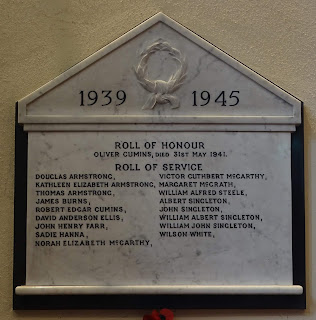The medals awarded during the 2nd World War were:
War Medal 1939-1945 was awarded for those who had served in the Armed Forces or Merchant Navy full-time for at least 28 days between 3 September 1939 and 2 September 1945. In the Merchant Navy, the 28 days must have been served at sea. It is sometimes described as the "Victory Medal" for WWII, although that is not its correct name.
Defence Medal was awarded for for service in WWII. It was instituted to recognise both military and some types of civilian service.
The following Campaign Medals were also awarded (in alphabetical order):
1939-1945 Star was awarded for for operational service between 3 September 1939 and 2 September 1945.
- Army personnel had to complete 6 months service in an operational command. Airborne troops qualified if they had participated in any airborne operations and had completed 2 months service in a fully operational unit.
- Air Force personnel had to participate in operations against the enemy providing that 2 months service had been completed in an operational unit. Non-aircrew personnel had to complete 6 months service in an area of (overseas) operational army command.
- Naval personnel qualified if they completed 6 months service, and at least 1 voyage was made through an operational area.
- Royal Observer Corps personnel for service of 1,080 days.

Africa Star was awarded for for a minimum of one day service in an operational area of North Africa between 10 June 1940 and 12 May 1943. The whole of the area between the Suez Canal and the Strait of Gibraltar is included, together with Malta, Abyssinia, Kenya, the Sudan, both Somaliands and Eritrea. The areas not bordering the Mediterranean only qualified for the Africa Star from 10 June 1940 to 27 November 1941.
Air Crew Europe Star was awarded for Commonwealth aircrew who participated in operational flights over Europe, from UK bases. Two months operational flying was required between 3 September 1939 and 5 June 1944 in order to qualify. The
1939-1945 Star must have been earned before commencing qualifying service for the Air Crew Europe Star. From 6 June 1944 (D-Day), operational flying over Europe qualified aircrew for the
France & Germany Star.
Atlantic Star was awarded for six months service afloat, in the Atlantic or in Home Waters, within the period 3 September 1939 to 8 May 1945. Also awarded to aircrew who have taken part in operations against the enemy at sea within the qualifying areas for Naval personnel, subject to two months service in an operational unit. The
1939-1945 Star must have been earned before commencing qualifying service for the Atlantic Star.
Burma Star was awarded for service in the Burma Campaign between 11 December 1941 and 2 September 1945. This medal was also awarded for certain specified service in China, Hong Kong, Malaya and Sumatra:
- Hong Kong - between 26 December 1941 and 2 September 1945
- China and Malaya - between 16 February 1942 and 2 September 1945
- Sumatra - between 24 March 1942 and 2 September 1945
Second World War service in China, Hong Kong, Malaya and Sumatra after 8 December 1941 but prior to the above start dates was recognised by the award of the
Pacific Star.
France & Germany Star was awarded for operational service in France, Belgium, Luxembourg, the Netherlands, and Germany from 6 June 1944 (D-Day) to 8 May 1945. The qualifying sea area is the North Sea south of a line from the Firth of Forth to Kristiansand (South), in the English Channel and in the bay of Biscay east of longitude 6 degrees west, provided such service was directly in support of land operations in France, Belgium, the Netherlands or Germany. British uniform regulations stipulated that neither the
Atlantic Star nor the
Air Crew Europe Star would be awarded to a recipient of the France and Germany Star. Subsequent entitlement to the Atlantic Star was denoted by the award of the Atlantic clasp. A clasp for the Air Crew Europe Star was not issued as that Star could not be earned after 5 June 1944. Army personnel who entered Austria may not qualify for this award, as their service is recognised by the grant of the
Italy Star.
Italy Star was awarded for operational service (on land) in Italy, Greece, Yugoslavia. Pantelleria, the Aegean area and Dodecanese Islands and Elba at any time between 11 June 1943 and 8 May 1945. Other areas to qualify for the award are:
- Sicily - between 11 June 1943 - 17 August 1943
- Sardinia - between 11 June 1943 - 19 September 1943
- Corsica- between 11 June 1943 - 4 October 1943
Pacific Star was awarded for operational service in the Pacific Theatre between 8 December 1941 and 2 September 1945, and also for certain specified service in China, Hong-Kong, Malaya and Sumatra:
- Hong Kong - between 8 December 1941 and 25 December 1941
- China and Malaya - between 8 December 1941 and 15 February 1942
- Sumatra - between 8 December 1941 and 23 March 1942

















































